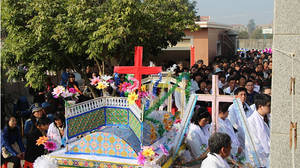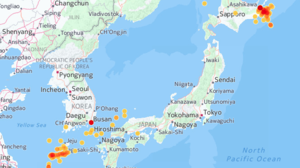Center for Asia Pacific Studies
The Center is San Francisco’s academic gateway to the Asia Pacific, fostering and promoting innovative research, teaching and public programs.
Volume XIII: Spring/Summer 2015
Asia Pacific Perspectives (ISSN: 2167-1699) is an international, peer-reviewed electronic journal that promotes cross-cultural understanding, tolerance, and the dissemination of knowledge about the Asia Pacific. The editors welcome submissions from all fields of the social sciences and the humanities that focus on the Asia Pacific, especially those adopting a comparative, interdisciplinary approach to issues of interrelatedness in the region. The journal facilitates academic discussions among both established scholars in the field and advanced graduate students. APP is published twice each year by the University of San Francisco Center for Asia Pacific Studies.

Christian funeral services and processions, replete with Christian-inspired banners and signs, church bands, and conspicuous crosses, are ways in which Protestant communities in South Fujian actively promote their faith. These events, which are often quite evangelistic, are more than simple demonstrations of faith. They are also formative because the expressions of social cohesion are meant to elevate the status of the church community or family in the eyes of society at large. This article will demonstrate that the renao (socially vibrant) atmosphere of Protestant funerals reflects how such activities are important avenues for church communities to gather and celebrate.

This paper, based on archival research undertaken in the General Headquarters (GHQ) / Supreme Command of Allied Powers (SCAP) archives and employing geospatial data, examines the origins of a number North East Asia’s territorial disputes through looking at the seizures of Japanese fishing boats during the initial postwar years.
Long before the carnage of the Pacific Theater in the Second World War commenced, U.S. government officials, scholars, shapers of public opinion, and the general public questioned the nature of Asian peoples. At the war’s outset, when faced with a visceral enemy and a prominent ally amongst the countries of Asia, officials and opinion-makers alike set out to educate the citizens of the United States about their Asian friends and foes. Many eminent historians such as John Dower, Yukiko Koshiro, and Christopher Thorne have chronicled the racial perceptions of the peoples of the United States and Japan towards one another during World War II and in the early stages of the Cold War, while other scholars have examined the U.S. racial perceptions of the Chinese in these same periods. Members of both scholarly groups acknowledge the transference of various stigmas and associations from Japan to China in the postwar period. As an analysis that looks at prevalent American racial attitudes toward the Japanese and Chinese peoples in both World War II and the Early Cold War, this article will help readers to understand better the nature of this transference. It will provide an introductory assessment of the varying U.S. orientalist and racial perceptions of the Chinese and Japanese peoples from World War II to the early postwar period.
This article will analyze the reasons why the vocal anti-TPP campaign was ultimately unsuccessful. In order to understand the behavior of the involved actors and groups, the article will focus on their diverse interests and motivations that reflect the comprehensive nature of the proposed trade agreement.
All nations assert cultural difference through contrast with other countries, and Japan is no exception. However, the country believes it is extraordinarily unique, and has built pervasive cultural myths that claim uniqueness to anything Japanese. Could “uniqueness” in Japanese art photography be one of those myths?
This article explores the impact of that repatriation on the Japanese homeland, and the social phenomena of scapegoating, alienation, and cultural prejudices that met many returnees. Using memoirs and cultural works, this article considers the experience of repatriation from 1945 to 1958. In so doing, it highlights the connection between repatriation, national identity, and Japan’s struggle with war guilt and responsibility as a defeated and occupied nation.